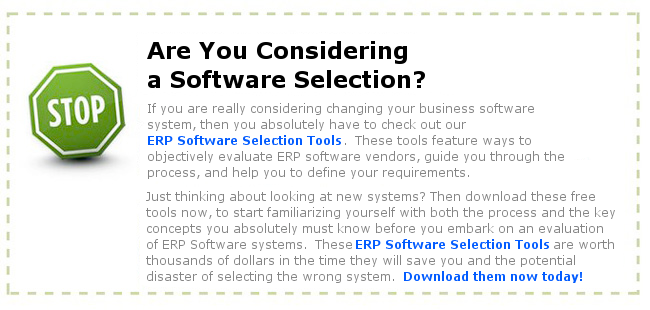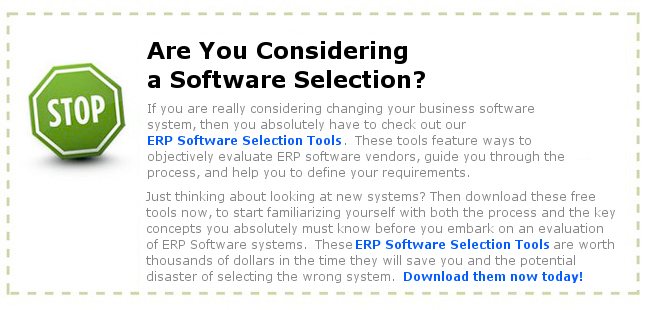Chris Shaul
Today, many ERP vendors are offering Lean Manufacturing modules in their solutions. These modules propose to assist companies in their lean effort. The real question is to what degree will these modules be used. Can a traditional manufacturer going to a lean model utilize a lean software tool immediately? When implementing an ERP system, process redesign is a must. The change that must occur in order to support an ERP system can be tremendous. But can a company bite off and digest all of the changes? Which should be done first, lean or ERP? These are all some of the questions that a typical manufacturing manager who is about to embark on an ERP implementation might ask.
First, lets define a few things. Lean is the removal of waste within a process and the concept of pulling items to a demand. It is also known as the Toyota Production system as it was developed and refined by Toyota in Japan. ERP is a business process enabled by software tools. It is not a software project! ERP streamlines your information flow such that it parallels your process flow. ERP works to build product to a forecast and then execute a production plan and inventory purchases synchronized to meet the predicted and actual demand. Lean, on the other hand, uses a pull system to meet an actual customer requirement. Lean uses the philosophy of smaller batches and reduction in non-value-added activities to create a much shorter lead time, thus delivering faster to a customer. ERP does not by its’ nature drive efficiencies in the production process. It only provides planners with information on what is going on and allows them to plan faster. If the process is broken, then automating it with the use of ERP will only highlight the problems.
What is the answer? The answer for many is to implement lean as part of an ERP intiative. Some would say that it should be a predecessor to an ERP initiative. Lean purists will argue that you do not need MRP and MPS to drive the production. ERP folks will argue that MRP and MPS are essential to having parts in-house and suppliers coordinated with the production. The answer for most companies is a hybrid solution, where lean is driving waste from the production and supply chain process (although also in the above-the-shop-floor activities too), while ERP is being implemented, such that you are automating value added processes and not trying to replicated waste processes in your new system. MRP can be used to plan longer lead time items, or items with higher value, whereas a Kanban can be setup for the faster turning and less expensive items.
Working from the perspective of a hybrid model, lean principles and practices can be implemented just prior to the ERP initiative. Then during the ERP implementation, the lean concepts must be considered and utilized in the setup of the new system. Tools such as Value Stream Mapping can define areas for quick improvements. Then once those improvements are made, a process flow based on the future state model can be applied to the ERP system. For example, a production cell might be setup for a particular product line with kanban inventory control. This would change how you would define your production process in the ERP system. Better ERP systems can run in this hybrid mode of traditional MRP and modern Lean concepts. Some product lines might be more suited to the MRP/MPS method because of supply chain issues or because of the long lead times that are associated with the products. Other product lines might be easy to immediately switch to flow manufacturing. Because of this, you want a system that can handle both methods.
Using a hybrid model, you select and position the ERP system to work alongside your lean initiatives. By leaning out processes (above and below the shop floor), you are avoiding “automating the mess.” Doing so will shorten lead times, reduce inventory, reduce production costs, improve employee moral and streamline your ERP implementation. Be sure to choose an implementation partner that is familiar with lean and is able to work in a hybrid manner. What order should these two tranforming intiatives occur? It might be best to have the lean initiative lead the ERP intiative by a few months. Then begin to implement the system. But do not stop the lean transformation. That should now be an ongoing philosophy of continual improvement. Use it to your advantage during the ERP implementation. Doing so will only help you on go-live day.
References:
http://www.advancedmanufacturing.com/September00/informationtech.htm
http://www.lean-manufacturing-info.com
http://www.qad.com/company/newsroom/lean_value.html
http://www.mapics.com/software/EE/SyteLine/sl7-aps.asp
http://www.cmtc.com/
http://www.inventoryinc.com/complimentary.html
Chris Shaul is a Sr. IT Consultant and specializes about ERP selections and implementations.

